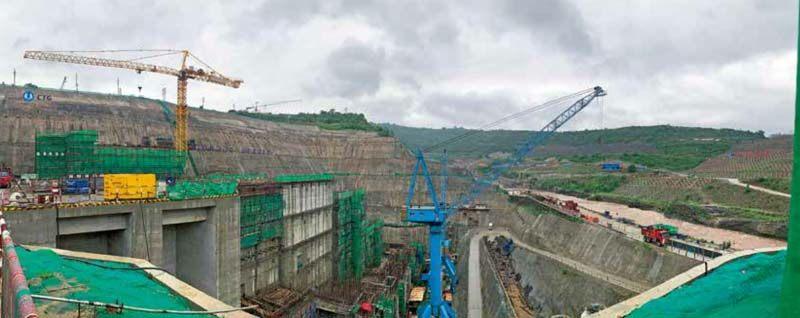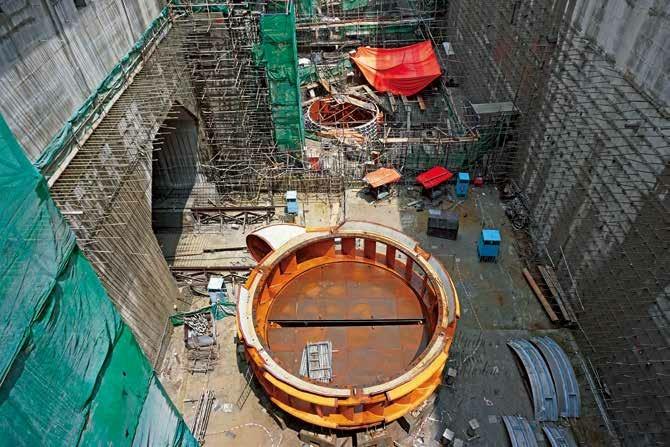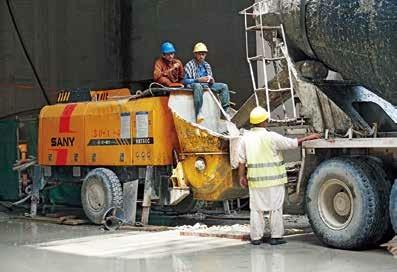卡洛特水电站:为巴铁电力续航
李卉嫔

7月末的巴基斯坦进入了雨季。清晨,位于旁遮普省的卡洛特水电站项目营地上空黑云压顶,暴雨如注。即使是这样恶劣的天气,水电站建设现场仍然是一片繁忙的景象。主厂房正处在紧张的施工阶段,中国水利水电第七工程局有限公司(以下简称“水电七局”)巴基斯坦卡洛特水电站项目部的工人们搭起雨篷,正在紧张地浇筑混凝土。浇灌车轰隆作响,工程车辆往来穿梭。从厂房交通隧洞进到内部,一个直径十数米的巨大圆环格外引人注目,这是未来发电的核心组件之一——水轮机蜗壳座环,它的成功安装也是发电站机电部分开始安装的重要标志。
吉拉姆河流经卡洛特桥上游的拐角处,厂房就建在这里一座被挖开山体100多米深的地方,从高空俯瞰,坝址所在处为吉拉姆河“几”字形河湾的头部位置,是建设水电站的黄金位置,能极大地缩减成本、降低施工难度。旁遮普(Punjab)意为“5条河”,而吉拉姆河是5河中最长的河流,混着泥沙的土黄色河水奔涌不息,从两条山脉间穿越而过,见证了水电七局人在这里奋斗的1000多个日日夜夜。
卡洛特水电站由三峡集团投资建设,总投资17.4亿美元,总装机容量720兆瓦,年发电量32.1亿度,投产后将满足300万人的用电需求,是中巴经济走廊框架下投资建设的首个水电站项目,也是巴基斯坦首个完全使用中国技术和中国标准建设的水电投资项目。这个经过了7年反复调研、勘察的水电站,于2015年12月奠基宣布正式开工建设,计划2021年3月实现并网发电。作为项目参建方之一,水电七局主要负责导流洞和厂房的建设。
在厂房建设现场,记者见到了水电七局卡洛特水电站项目部副总工程师何洲海,“刚来时,这里全是山脉,我们挖了300多万土方出来,才形成现在的主厂房所在地。”何洲海回忆道,7月-9月是巴基斯坦的雨季,那时几乎天天下雨,道路被雨水泥泞阻断,开挖车辆无法到达施工点,工程进展尤为缓慢。而4月-6月是巴基斯坦最热的季节,气温高达50摄氏度,现场作业是个巨大的考验。
而对水电七局人来说,困难还远不止这些。要在一个以欧美标准为主的国家建成第一个中国标准的水电站,在当地找到满足中国标准要求的高质量材料就不是那么简单。
“我们用了一年多时间,才在当地找到能为我们生产中国标准材料的厂家。”何洲海告诉记者,开始,在发现本地材料不符合建设标准时,他们考虑从国内采购材料,但因征收关税后,价格要比国内翻一番,这将远远超出合同预算。不仅如此,当地人时间观念薄弱,办事拖拉,供货常常被拖延,加之当地工人流动性大、随意性强,这对当地员工占70%以上、土方开挖阶段甚至高达90%以上的项目来说,无疑是一个很大的挑戰。
作业队队长黄忠也表示,在海外做工程从来不是一件容易的事,回想上一个项目——高摩赞水电站,他感觉自己简直在生死边缘走了一遭,至今想来还后怕不已。高摩赞位于临近巴基斯坦与阿富汗边界,因被绑架的两名中国工程师牺牲了一名后被迫中断了两年,即使后来巴方派了边防军保护,也有几名当地员工曾被绑架过。他回忆说,当时甚至有一枚炮弹在他们的休息营地炸开。
为保证卡洛特水电站项目按照计划进行,水电七局的工程师们不断优化调整施工方案,加强与巴方员工的沟通交流,项目建设逐渐走向正轨。项目部经理助理兼工程管理部主任任志民告诉记者,与国内干工程不同的是,这里的项目设计方案随时可能因为施工环境的变化而作出调整,施工方必须与设计方一直保持密切沟通协调,减少图纸修改和再审批环节时间。
中国企业在海外建工程,一直坚持推行属地化管理,大量招聘当地员工。中企多年的努力不仅为其建设的工程赢得了良好口碑,也为自己收获了一大批当地的忠实“粉丝”。
在卡洛特水电站项目施工现场,记者就碰到了四位一直跟随水电七局做项目的巴基斯坦本地员工。见到记者,他们都热情地涌上来展示他们学到的中文,“阀门”“三通”“晓得了吧”“拿过来嘛”……有的甚至说着四川方言。尽管没有经过专门的汉语培训,会说的英语也十分有限,但长时间与中国工程师打交道的他们,以汉语+英语+乌尔都语(巴基斯坦国语)的神奇语言组合,居然也与中国工程师自如交流、默契合作。
据水电七局工作人员透露,他们都是水电七局在巴基斯坦第一个水电站——高摩赞水电站项目的员工,这一跟就是10年以上,有的甚至长达17年。有人给记者展示了他的工号,81号,在编号已到6000多号的当地员工中,排名非常靠前。他们抢着跟记者说,中国工程师的耐心指导、体贴包容让他们十分感动,宰牲节时还会自掏腰包给他们买羊过节,这些都让他们愿意尽心尽力地完成工作,不负“老师”的期待和重托。而他们的努力也得到了丰厚回报,现在每个月能拿到近4万卢比的工资,这几乎是当地普通工人工资收入的两倍。

曾在高摩赞水电站干了7年的作业队队长黄忠也透露,跟随他一起从高摩赞来到卡洛特的巴方员工共有300多人,长期相处结下的友谊,让他们更了解彼此,不需要长时间磨合,就能很好地配合工作。
除了这些普通雇员,当地高级雇员愿意跟随同一家中国企业的也不少。阿姆加德(Amjad)是水电七局卡洛特水电站项目部的人事经理,第一次与中国人合作就是在中国水电公司加纳的项目,这一次经朋友介绍来到水电七局在巴基斯坦的水电站项目,他感慨良多。他表示,只要是水电七局的项目,他都希望能继续跟着干下去。
工作优秀的他年年被卡洛特项目部评为优秀员工,2017年、2018年还连续两年被水电七局总部评为优秀员工。今年2月,阿姆加德受邀到成都参加活动,遗憾的是此次成都之行却因其父亲突然去世临时取消。与中国企业、中国人共事6年的经历,让阿姆加德对中国人的工作作风尤为敬佩。“中国人工作勤奋努力,目标明确,制定计划后严格遵循,很值得我们学习,我非常乐意有这样一群工作伙伴。”他希望有机会到中国去生活,学习中文和中华文化,更深入地了解中国人的生活。“我有19年的人力资源工作经验,如果我再学会中文,这将更有助于我在中国企业的工作。”阿姆加德满怀希望地说道。
巴基斯坦夏季炎热难耐,在没有空调的房间里,仿佛置身于一个大蒸笼中,窒息难受,晚上更是热得无法入睡。
电力供应不足,停电在巴基斯坦是家常便饭。官方数据显示,2018年巴基斯坦全国日均电力缺口为400万度,夏季用电高峰时期日均电力缺口高达750万度。加之电价高昂、电压不足等因素,耗电高的空调在这里尚属奢侈品。
“我家如果每个房间都装上空调,每个月电费就得近4万卢比,这相当于我半个月的工资。”阿姆加德提起电费一脸肉疼,作为高级雇员的他,妻子是一名老师,夫妻二人的总收入加在一起,在巴基斯坦也算是中产了,提起用空调的电费支出也是一脸无奈,更别说普通家庭了。他迫切希望能有更多电站建成,电价就能便宜些,夏天也就不会那么难熬了。
近年来,尤其是中巴经济走廊建设开始以后,在中国的帮助下,很多电站项目已完成建设并网发电,正在逐步弥补巴基斯坦的电力供应缺口。巴基斯坦水电发展署(WAPDA)统计显示,中国在“一带一路”沿线投资建设的前10大发电站项目,有8个在巴基斯坦。而中巴经济走廊规划中优先实施的电站项目共计12334兆瓦,总投资额高达250亿美元。
1320兆瓦卡西姆燃煤电站、1320兆瓦萨希瓦尔燃煤电站、969兆瓦尼鲁姆·杰鲁姆水电站、1410兆瓦塔贝拉电站扩建工程等项目先后于2017年、2018年实现并网发电,巴基斯坦全境电力短缺情况得到了极大缓解。2018年4月,卡西姆电站顺利进入商业运行,截至2018年底累积发电超过75亿度,其发电量相当于巴基斯坦目前全国发电量的10%, 今后每年发电量将达90亿度,满足巴基斯坦400万户家庭,超过2000万人的用电需求。萨希瓦尔电站投产后一直维持高负荷稳定运营,填补了巴基斯坦四分之一的用电缺口。
据当地人介绍,伊斯兰堡、拉合尔等主要城市2017年前平均每天每隔3小时就要停电一小时,有的城市甚至全天有一半以上时间都处于停电状态,现在拉合尔等主要城市除了每周例行的电力检修要停电一次外,基本都不再停电。
更多的电站项目正在建设或规划中,包括1320兆瓦塔尔Oracle坑口燃煤电站、1100兆瓦科哈拉水电站、873兆瓦苏基克纳里水电站等等。就像巴基斯坦总理伊姆兰·汗所说,巴基斯坦计划将在10年内大幅减少对进口能源燃料的依赖,充分利用中巴经济走廊建设的水电、可再生能源、煤电等能源项目来减少能源缺口。
未来可期,随着一大批电站并网发电,巴基斯坦将彻底告别电力短缺及停电苦恼,空调将成为人民生活中的必备品和常用品,自在享受清凉一夏。
At the end of July, Pakistan entered into the rainy season. In the early morning, the resident of Karot Hydroelectric Power Station Project in Punjab Province witnessed a storm of rain falling from thick dark clouds. Despite such bad weather, the construction site still presented a scenario of furious productivity. The main plant was under intense construction, where workers of Karot Hydroelectric Power Station Project from Sinohydro Bureau 7 Co. Ltd. (hereinafter referred to as Sinohydro Bureau 7) were busy with concrete placement after putting up awnings. As the concrete-mobiles were clattering, the construction vehicles crisscrossed at the site. As we walked from the traffic tunnel to the inside of the plant, a huge ring with a diameter of ten-plus meters was particularly eye-catching, which was one of the core components of future power generation--the stay ring and spiral casing of hydraulic turbine. Its successful installation is also an important symbol for the installation of the electromechanical part of the power station.
The Jehlum River passes through the corner of the upper reaches of the Karot Bridge, where the plants were built more than 100 meters deep in a mountain that had been excavated. If we look down from high altitudes, the dam site is located at the top of the “Ω”shaped Jehlum river, which is the golden position for the construction of the hydroelectric power station, thus greatly reducing the costs and the construction difficulties. The word Punjab refers to “five rivers”, of which the Jehlum River is the longest river. The turbid river mixed with mud rushed through the mountains and witnessed the 1,000 plus days and nights that the workers of Sinohydro Bureau 7 have spent here.
The Karot Hydroelectric power Station is invested and constructed by the Three Gorges Corporation with a total investment of USD 1.74 billion, which has a total installed capacity of 720 megawatts and generates 3.21 billion kWh of electricity every year. Once the project is put into operation, it will meet the electricity demand of 3 million people. It is the first hydroelectric power station project invested under the framework of the China-Pakistan Economic Corridor, as well as the first hydroelectric power investment project in Pakistan that uses Chinese technologies and Chinese standards. This hydroelectric power project, which had been repeatedly investigated and surveyed for 7 years, broke ground and started construction officially in December 2015. It was originally planned to realize grid-connected power generation in March 2021. As one of the project participants, the Sinohydro Bureau 7 is mainly responsible for the construction of diversion tunnels and factories.
At the construction site of the plant, the reporter saw He Zhouhai, deputy chief engineer of the Karot Hydroelectric Power Station Project from Sinohydro Bureau 7 Co. Ltd. “When we first arrived, it was all mountain ranges here. We dug more than 3 million cubic meters of earthwork before forming the current main plant location”. He Zhouhai recalled that it was the rainy season in Pakistan from July to September when it rained almost every day. The road would be blocked by rain cement, so the excavation vehicles could not reach the construction site, making it extremely hard for the project to make progress. April-June was the hottest season in Pakistan, with temperatures as high as 50 degrees Celsius when fieldwork became a huge test.

For the workers of Sinohydro Bureau 7, the difficulties were far more than that. To build the first hydroelectric power station with the first Chinese standards in a country dominated by European and American standards, it is not so easy to find highquality materials that meet the requirement of the Chinese standards in the local area.
“It took us more than a year to find a local manufacturer that could produce the materials with Chinese standard for us.” He Zhouhai told reporters that at the beginning, when they found that local materials failed to meet the construction standards, they considered purchasing materials from China. But the price would be doubled that of China due to the tariffs, which would far exceed the contract budget. In addition, the local people’s time concept was so weak that delay in handling matters led to delay in providing supply, compounded by highly mobile local workers who often did things arbitrarily. It was undoubtedly a big challenge for such a project where local employees made up 70% of the total workers and even more than 90% in the earthwork excavation.
Huang Zhong, the leader of the operation team, also said that it was never an easy task to do engineering abroad. When he recalled the last project, Gomal Zam Hydroelectric Power Station, he still felt that he had just walked on the edge of life and death with a panic fear. Gomal Zam is located near the border between Pakistan and Afghanistan. The project was interrupted for two years as two Chinese engineers were kidnapped and one of them was killed. Even after the Pakistani side sent border guards to protect them, several local employees were once kidnapped. He recalled that there was even a shell that exploded in their rest camp at that time.
In order to ensure that the Karot Hydropower Project could be carried out according to the plan, the engineers of Sinohydro Bureau 7 kept optimizing and adjusting the construction plans and strengthening communication with the Pakistani employees, placing the project construction on the right track. Ren Zhimin, Assistant Manager of the Project Department and Director of the Engineering Management Department, told the reporter that the project design plan here might be adjusted at any time due to changes in the construction environment, which was different from the domestic projects. The construction party must maintain close communication and coordination with the design side in order to reduce the time for modification and reapproval of drawings.
In overseas projects, Chinese enterprises have been implementing localized management by recruiting a large number of local employees. Chinese enterprises have made great efforts these years, winning not only a good reputation for the construction of the project, but also a large number of local loyal “fans” for themselves.
At the construction site of the Karot Hydroelectric power Project, the reporter encountered four local Pakistani employees who had been working with Sinohydro Bureau 7. Seeing the reporter, they all enthusiastically came up to show the Chinese they learned, such as “valve”, “three-way valve”, “got it?”, “hand it to me”. Some of them even spoke Sichuan dialect. Without special Chinese training, they could speak only a limited amount of English. It was surprising that they managed to communicate and cooperate with Chinese engineers with a magic combination of Chinese, English and Urdu (the national language of Pakistan).
According to the staff from Sinohydro Bureau 7, they have been working for more than 10 years, and some even for as long as 17 years in the Gomal Zam Hydroelectric Power Project, the first hydroelectric power station in Pakistan. One of them showed the reporter his job number, No. 81, a quite early number among the 6,000 local employees. They told the reporter with eagerness that they were really touched by the patient guidance and thoughtfulness of Chinese engineers, who also bought sheep out of their own pocket for the feast of the Eid Adha(a religious festival). All that made them willing to do their best to fulfill the work and live up to the expectations and great trust of the “teachers”. Their efforts have also paid off handsomely, because now they can earn nearly 40,000 Pakistani rupees a month, which is almost twice the wage of an ordinary local worker.
Huang Zhong, the leader of the operation team who had worked at the Gomal Zam Hydroelectric Power Station for seven years, also revealed that there were more than 300 employees who had been working with them from Gomal Zam to Karot. They didn’t need a long time to warm up to each other before working well together as they knew each other better after long-term relationship and friendship.
Apart from these employees at lower level, there were quite a few local senior employees who were willing to follow the same Chinese company. Amjad was the HR manager of the Karot Hydroelectric Power Station Project of Sinohydro, who made his first cooperation with Chinese in a Ghana project in the charge of Sinohydro. This time when he joined the hydroelectric power project in Pakistan to work with Sinohydro Bureau 7 Co. Ltd. after a friend’s introduction, he was deeply moved. He said that he hoped to follow the project as long as it was a project of Sinohydro Bureau 7 Co. Ltd.
He had been chosen as one of the best employees by the Karot Project Department every year for his excellent work. What’s more, he was also prized as one of the best employees by the headquarters of Sinohydro Bureau 7 Co. Ltd. for two consecutive years in 2017 and 2018. In this February, Amjad was invited to participate in the event in Chengdu, but unfortunately the trip was temporarily canceled due to the sudden death of his father. Having been working with Chinese companies and workers, Amjad was particularly impressed by the Chinese work style. “The Chinese work hard with a clear goal. They stick to their plans once they are formulated, which is worth learning. I am very happy to have such a group of working partners.” He hoped to have the opportunity to live in China and learn Chinese language and cultures, thus gaining a better understanding of Chinese people’s life. “As I am equipped with 19 years of HR work experience, it will be beneficial for my work in Chinese companies if I have a good command of Chinese.” said Amjad hopefully.
In summer, it is unbearably hot in Pakistan. It feels like to be in a big steamer in a room without air conditioning. Suffocated and uncomfortable, it’s too hot for people to sleep at night.
Blackouts are a normal state in Pakistan due to insufficient power supply. According to the official data, the average daily power shortage in Pakistan reached 4 million KWH in 2018, and it even reached 7.5 million KWH when there’s a surge in electricity demand in summer. Apart from that, the high electricity prices, insufficient voltage and other factors all made air-conditioners a luxury here.

“If every room in my house were air-conditioned, the monthly electricity bill would reach nearly 40,000 Pakistani rupees, which is equivalent to half of my monthly salary.” Amjad begrudged the money spent on electricity. He was a senior employee himself and his wife was a teacher. Their combined income made them middle class in Pakistan. Even they could not afford to pay for the electricity bill, not to mention ordinary families. He was eager to see more power stations built so that electricity prices can be cheaper, and it wouldn’t be so hard to bear in summer.
In recent years, especially after the construction of the China-Pakistan Economic Corridor began, thanks to the help of China, many power station projects have been completed and connected to the grid to generate electricity, which has gradually filled the power supply gap in Pakistan. Statistics from the Water and Power Development Authority (WAPDA) showed that eight of the top 10 power station projects are in Pakistan, which are invested by China along the Belt and Road. The power station projects, which will be implemented as the priority of the China-Pakistan Economic Corridor, are expected to generate 12,340MW with a total investment of USD 25 billion.
Projects such as 1,320MW of the Qasim Coalfired Power Plant, 1,320MW of the Sahiwal Coalfired Power Station, 969MW of the Neelun-Jhelum Hydroelectric Power Station, as well as the expansion of 1,410MW of the Tarbela Power Station were completed and connected to the grid in 2017 and 2018, which greatly alleviated the power shortage in Pakistan. In April 2018, the Qasim Power Plant was put into commercial operation, which had generated more than 7.5 billion KWH of electricity, equivalent to 10% of the current national electricity generation in Pakistan by the end of 2018. In the future, the annual power generation will reach 9 billion kWh, meeting the needs of more than 20 million people and 4 million households in Pakistan. Since the Sahiwal Coal-fired Power Station was put into operation, it has maintained a high load and stable operation, resolving a quarter of the electricity shortage in Pakistan.
According to the local people, some major cities such as Islamabad and Lahore would have a one-hour blackout every three hours each day, and the power was cut off even for more than half of the day in some cities before 2017. At present, there is no power failure in the major cities such as Lahore except for the sake of the weekly power maintenance.
More power station projects are under construction or planning, including 1,320MW of the Tar Oracle Coal-pit Mouth Power Plants, 1,100MW of the Kohala Hydroelectric Power Station, and 873MW of the Suki Kinari Hydroelectric Power Station. As Imran Khan, Prime Minister of Pakistan had said, Pakistan planned to significantly reduce its dependence on imported energy fuels within 10 years by making full use of energy projects such as hydropower, renewable energy as well as coal and electricity built by the China-Pakistan Economic Corridor, thus reducing its energy gaps.
In the future, Pakistan will completely bid farewell to power shortage and power failure with a large number of power stations connected to the grid for power generation. Air conditioners will become a must-have and common item in people’s lives, which allows them to enjoy a cooler summer.

